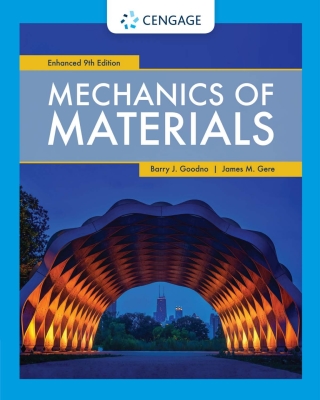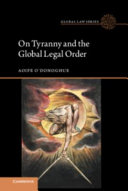Buy Mechanics of Materials, Enhanced Edition, 9th Edition PDF ebook by author Barry J. Goodno; James M. Gere – published by Cengage Learning in 2021 and save up to 80% compared to the print version of this textbook. With PDF version of this textbook, not only save you money, you can also highlight, add text, underline add post-it notes, bookmarks to pages, instantly search for the major terms or chapter titles, etc.
You can search our site for other versions of the Mechanics of Materials, Enhanced Edition, 9th Edition PDF ebook. You can also search for others PDF ebooks from publisher Cengage Learning, as well as from your favorite authors. We have thousands of online textbooks and course materials (mostly in PDF) that you can download immediately after purchase.
Note: e-textBooks do not come with access codes, CDs/DVDs, workbooks, and other supplemental items.
eBook Details:
Full title: Mechanics of Materials, Enhanced Edition, 9th Edition
Edition: 9th
Copyright year: 2021
Publisher: Cengage Learning
Author: Barry J. Goodno; James M. Gere
ISBN: 9780357377918, 9780357377918
Format: PDF
Description of Mechanics of Materials, Enhanced Edition, 9th Edition:
Develop a thorough understanding of the mechanics of materials – an area essential for success in mechanical, civil and structural engineering — with the analytical approach and problem-solving emphasis found in Goodno/Gere’s leading MECHANICS OF MATERIALS, ENHANCED, 9th Edition. This book focuses on the analysis and design of structural members subjected to tension, compression, torsion and bending. This ENHANCED EDITION guides you through a proven four-step problem-solving approach for systematically analyzing, dissecting and solving structure design problems and evaluating solutions. Memorable examples, helpful photographs and detailed diagrams and explanations demonstrate reactive and internal forces as well as resulting deformations. You gain the important foundation you need to pursue further study as you practice your skills and prepare for the FE exam.Important Notice: Media content referenced within the product description or the product text may not be available in the ebook version.
Table of Contents of Mechanics of Materials, Enhanced Edition, 9th Edition PDF ebook:
ContentsAbout the AuthorsPrefaceDigital ResourcesSymbolsGreek AlphabetChapter 1: Tension, Compression, and Shear1.1 Introduction to Mechanics of Materials1.2 Problem-Solving Approach1.3 Statics Review1.4 Normal Stress and Strain1.5 Mechanical Properties of Materials1.6 Elasticity, Plasticity, and Creep1.7 Linear Elasticity, Hooke’s Law, and Poisson’s Ratio1.8 Shear Stress and Strain1.9 Allowable Stresses and Allowable Loads1.10 Design For Axial Loads and Direct ShearChapter Summary and ReviewProblemsChapter 2: Axially Loaded Members2.1 Introduction2.2 Changes in Lengths of Axially Loaded Members2.3 Changes in Lengths under Nonuniform Conditions2.4 Statically Indeterminate Structures2.5 Thermal Effects, Misfits, and Prestrains2.6 Stresses on Inclined Sections2.7 Strain Energy*2.8 Impact Loading*2.9 Repeated Loading and Fatigue*2.10 Stress Concentrations*2.11 Nonlinear Behavior*2.12 Elastoplastic AnalysisChapter Summary and ReviewProblemsChapter 3: Torsion3.1 Introduction3.2 Torsional Deformations of a Circular Bar3.3 Circular Bars of Linearly Elastic Materials3.4 Nonuniform Torsion3.5 Stresses and Strains in Pure Shear3.6 Relationship between Moduli of Elasticity E and G3.7 Transmission of Power by Circular Shafts3.8 Statically Indeterminate Torsional Members3.9 Strain Energy in Torsion and Pure Shear3.10 Torsion of Noncircular Prismatic Shafts3.11 Thin-Walled Tubes*3.12 Stress Concentrations in TorsionChapter Summary and ReviewProblemsChapter 4: Shear Forces and Bending Moments4.1 Introduction4.2 Types of Beams, Loads, and Reactions4.3 Shear Forces and Bending Moments4.4 Relationships among Loads, Shear Forces, and Bending Moments4.5 Shear-Force and Bending-Moment DiagramsChapter Summary and ReviewProblemsChapter 5: Stresses in Beams (Basic Topics)5.1 Introduction5.2 Pure Bending and Nonuniform Bending5.3 Curvature of a Beam5.4 Longitudinal Strains in Beams5.5 Normal Stress in Beams (Linearly Elastic Materials)5.6 Design of Beams for Bending Stresses5.7 Nonprismatic Beams5.8 Shear Stresses in Beams of Rectangular Cross Section5.9 Shear Stresses in Beams of Circular Cross Section5.10 Shear Stresses in the Webs of Beams with Flanges*5.11 Built-Up Beams and Shear Flow*5.12 Beams with Axial Loads*5.13 Stress Concentrations in BendingChapter Summary and ReviewProblemsChapter 6: Stresses in Beams (Advanced Topics)6.1 Introduction6.2 Composite Beams6.3 Transformed-Section Method6.4 Doubly Symmetric Beams with Inclined Loads6.5 Bending of Unsymmetric Beams6.6 The Shear-Center Concept6.7 Shear Stresses in Beams of Thin-Walled Open Cross Sections6.8 Shear Stresses in Wide-Flange Beams6.9 Shear Centers of Thin-Walled Open Sections*6.10 Elastoplastic BendingChapter Summary and ReviewProblemsChapter 7: Analysis of Stress and Strain7.1 Introduction7.2 Plane Stress7.3 Principal Stresses and Maximum Shear Stresses7.4 Mohr’s Circle for Plane Stress7.5 Hooke’s Law for Plane Stress7.6 Triaxial Stress7.7 Plane StrainChapter Summary and ReviewProblemsChapter 8: Applications of Plane Stress (Pressure Vessels, Beams, and Combined Loadings)8.1 Introduction8.2 Spherical Pressure Vessels8.3 Cylindrical Pressure Vessels8.4 Maximum Stresses in Beams8.5 Combined LoadingsChapter Summary and ReviewProblemsChapter 9: Deflections of Beams9.1 Introduction9.2 Differential Equations of the Deflection Curve9.3 Deflections by Integration of the Bending-Moment Equation9.4 Deflections by Integration of the Shear-Force and Load Equations9.5 Method of Superposition9.6 Moment-Area Method9.7 Nonprismatic Beams9.8 Strain Energy of Bending*9.9 Castigliano’s Theorem*9.10 Deflections Produced by Impact*9.11 Temperature EffectsChapter Summary and ReviewProblemsChapter 10: Statically Indeterminate Beams10.1 Introduction10.2 Types of Statically Indeterminate Beams10.3 Analysis by the Differential Equations of the Deflection Curve10.4 Method of Superposition*10.5 Temperature Effects*10.6 Longitudinal Displacements at the Ends of a BeamChapter Summary and ReviewProblemsChapter 11: Columns11.1 Introduction11.2 Buckling and Stability11.3 Columns with Pinned Ends11.4 Columns with Other Support Conditions11.5 Columns with Eccentric Axial Loads11.6 The Secant Formula for Columns11.7 Elastic and Inelastic Column Behavior11.8 Inelastic Buckling11.9 Design Formulas for ColumnsChapter Summary and ReviewProblemsReferences and Historical NotesAppendix A: Systems of Units and Conversion FactorsAppendix B: Problem SolvingAppendix C: Mathematical FormulasAppendix D: Review of Centroids and Moments of InertiaAppendix E: Properties of Plane AreasAppendix F: Properties of Structural-Steel ShapesAppendix G: Properties of Structural LumberAppendix H: Deflections and Slopes of BeamsAppendix I: Properties of MaterialsAnswers to ProblemsIndex





